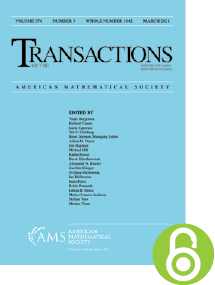A decomposition for combinatorial geometries
HTML articles powered by AMS MathViewer
- by Thomas H. Brylawski PDF
- Trans. Amer. Math. Soc. 171 (1972), 235-282 Request permission
Abstract:
A construction based on work by Tutte and Grothendieck is applied to a decomposition on combinatorial pregeometries in order to study an important class of invariants. The properties of this Tutte decomposition of a pregeometry into a subgeometry $G\backslash e$ and contraction $G/e$ is explored in a categorically integrated view using factored strong maps. After showing that direct sum decomposition distributes over the Tutte decomposition we construct a universal pair $(R,t)$ where $R$ is a free commutative ring with two generators corresponding to a loop and an isthmus; and $t$, the Tutte polynomial assigns a ring element to each pregeometry. Evaluations of $t(G)$ give the Möbius function, characteristic polynomial, Crapo invariant, and numbers of subsets, bases, spanning and independent sets of $G$ and its Whitney dual. For geometries a similar decomposition gives the same information as the chromatic polynomial throwing new light on the critical problem. A basis is found for all linear identities involving Tutte polynomial coefficients. In certain cases including Hartmanis partitions one can recover all the Whitney numbers of the associated geometric lattice $L(G)$ from $t(G)$ and conversely. Examples and counterexamples show that duals, minors, connected pregeometries, series-parallel networks, free geometries (on which many invariants achieve their upper bounds), and lower distributive pregeometries are all characterized by their polynomials. However, inequivalence, Whitney numbers, and representability are not always invariant. Applying the decomposition to chain groups we generalize the classical two-color theorem for graphs to show when a geometry can be imbedded in binary affine space. The decomposition proves useful also for graphical pregeometries and for unimodular (orientable) pregeometries in the counting of cycles and co-boundaries.References
- George D. Birkhoff, A determinant formula for the number of ways of coloring a map, Ann. of Math. (2) 14 (1912/13), no. 1-4, 42–46. MR 1502436, DOI 10.2307/1967597
- Thomas H. Brylawski, A combinatorial model for series-parallel networks, Trans. Amer. Math. Soc. 154 (1971), 1–22. MR 288039, DOI 10.1090/S0002-9947-1971-0288039-7 —, The Möbius function as decomposition invariant, Proc. Waterloo Conference on Möbius Algebras, 1971, pp. 143-148. —, The Tutte-Grothendieck ring (to appear). A. Cayley, A theorem on trees, Quart. J. Math. 23 (1889), 376-378.
- Henry H. Crapo, A higher invariant for matroids, J. Combinatorial Theory 2 (1967), 406–417. MR 215744, DOI 10.1016/S0021-9800(67)80051-6
- Henry H. Crapo, Möbius inversion in lattices, Arch. Math. (Basel) 19 (1968), 595–607 (1969). MR 245483, DOI 10.1007/BF01899388
- Henry H. Crapo, The Tutte polynomial, Aequationes Math. 3 (1969), 211–229. MR 262095, DOI 10.1007/BF01817442
- Henry H. Crapo, The Möbius function of a lattice, J. Combinatorial Theory 1 (1966), 126–131. MR 193018, DOI 10.1016/S0021-9800(66)80009-1
- Henry H. Crapo and Gian-Carlo Rota, On the foundations of combinatorial theory: Combinatorial geometries, Preliminary edition, The M.I.T. Press, Cambridge, Mass.-London, 1970. MR 0290980
- Juris Hartmanis, Lattice theory of generalized partitions, Canadian J. Math. 11 (1959), 97–106. MR 99931, DOI 10.4153/CJM-1959-013-8
- D. A. Higgs, Strong maps of geometries, J. Combinatorial Theory 5 (1968), 185–191. MR 231761, DOI 10.1016/S0021-9800(68)80054-7
- George J. Minty, On the axiomatic foundations of the theories of directed linear graphs, electrical networks and network-programming, J. Math. Mech. 15 (1966), 485–520. MR 0188102
- Gian-Carlo Rota, On the foundations of combinatorial theory. I. Theory of Möbius functions, Z. Wahrscheinlichkeitstheorie und Verw. Gebiete 2 (1964), 340–368 (1964). MR 174487, DOI 10.1007/BF00531932 —, Hedrick lectures, Math. Assoc. of Amer. Annual Meeting, Toronto, 1967.
- Richard P. Stanley, Modular elements of geometric lattices, Algebra Universalis 1 (1971/72), 214–217. MR 295976, DOI 10.1007/BF02944981
- W. T. Tutte, A contribution to the theory of chromatic polynomials, Canad. J. Math. 6 (1954), 80–91. MR 61366, DOI 10.4153/cjm-1954-010-9
- W. T. Tutte, A ring in graph theory, Proc. Cambridge Philos. Soc. 43 (1947), 26–40. MR 18406, DOI 10.1017/s0305004100023173
- W. T. Tutte, Lectures on matroids, J. Res. Nat. Bur. Standards Sect. B 69B (1965), 1–47. MR 179781, DOI 10.6028/jres.069B.001 —, Introduction to the theory of matroids, American Elsevier, New York, 1970.
- Hassler Whitney, On the Abstract Properties of Linear Dependence, Amer. J. Math. 57 (1935), no. 3, 509–533. MR 1507091, DOI 10.2307/2371182
Additional Information
- © Copyright 1972 American Mathematical Society
- Journal: Trans. Amer. Math. Soc. 171 (1972), 235-282
- MSC: Primary 05B25
- DOI: https://doi.org/10.1090/S0002-9947-1972-0309764-6
- MathSciNet review: 0309764


